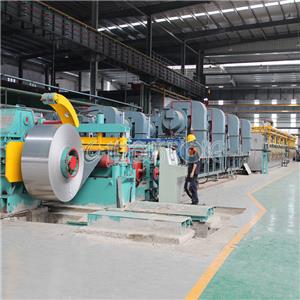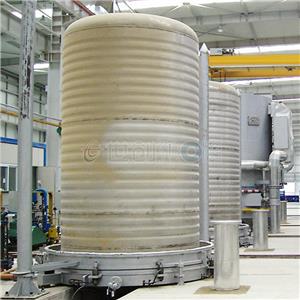Heat treatment types of stainless steel
Heat treatment of stainless steels is mostly carried out under controlled conditions to avoid carburization, decarburization and scaling on the metal surface.
Annealing
Annealing, or solution treatment, is employed for recrystallizing the work-hardened austenitic stainless steels and drawing chromium carbides, precipitated around the work-hardened stainless steels, into the solution. In addition, this treatment removes stresses occurred during cold-working, and homogenizes dendritic stainless steel welds.
Annealing of stainless steels is carried out at temperatures greater than 1040°C, but certain types of steel can be annealed at very controlled temperatures of below 1010°C while considering fine grain size. The process is maintained for a short interval, in order to prevent surface scaling and control grain growth.
Quench Annealing
Quench annealing of austenitic stainless steel is a process of rapidly cooling the metal by water quenching to overcome sensitization.
Stabilizing Anneal
A stabilizing anneal is often carried out following conventional annealing of grades 321 and 347. Carbon present in the composition of these grades is allowed to combine with titanium in grade 321, and niobium in grade 347, during annealing. Precipitation of carbon, in the form of niobium or titanium carbide, occurs by further annealing at temperatures of 870 to 900°C for 2 to 4 h, followed by rapid-cooling, thereby preventing precipitation of chromium carbide.
This treatment can be performed under rigorously corrosive operating conditions or conditions that involve temperatures ranging from 400 to 870°C.
Cleaning
The surface of austenitic stainless steels must be thoroughly cleaned, to eliminate carbonaceous residues, grease and oil, prior to heat treatment or annealing because the presence of residues results in carburization that, in turn, reduces corrosion resistance properties.
Process Annealing
All Ferritic and martensitic stainless steels can be process annealed by heating in the ferrite temperature range, or fully annealed by heating above the critical temperature in the austenite range. Sub-critical annealing can be carried out, usually in temperatures from 760 to 830°C. Soft structure of spheroidised and ferrite carbides can be produced by cooling the material at 25°C from full annealing temperature for an hour, or holding the material for an hour at subcritical annealing temperature. Products that have been cold-worked following full annealing can be annealed at subcritical temperatures in less than 30 min.
The Ferritic steel grades retaining single-phase structures throughout the operating temperature range require nothing more than short recrystallization annealing at temperatures of 760 to 955°C.
Controlled Atmospheres
Stainless steels are generally annealed in controlled conditions to reduce scaling. This treatment can be carried out in a salt bath, but bright annealing performed in highly reducing conditions is mostly preferred. Manufacturers carry out bright annealing of wire, tube and flat rolled coil products in the presence of hydrogen and nitrogen. Bright annealed products are referred to as “BA”.
Hardening
Like low alloy steels, martensitic stainless steels are hardened using tempering, quenching and austenitising. Austenitising temperatures range from 980 to 1010°C. At austenitising temperature of 980°C, as-quenched hardness tends to increase first and then drops, following retention. The optimum austenitising temperature for certain steel grades may be based on the temperature of the following process tempering.
Cracking in intricate sections of high and low carbon steels can be prevented through pre-heating the steels at 790°C prior to austenitising.
Cooling and Quenching
Martensitic stainless steels have high alloy content and, hence, high hardenability. Full hardness can be achieved through air-cooling at the austenitising temperature, but hardening larger sections may sometimes require oil quenching. Hardened components must be tempered immediately after cooling at room temperature, particularly if oil quenching has been used to prevent cracking. In some cases, components are frozen at -75°C prior to tempering. Tempering of martensitic steels is performed at temperatures greater than 510°C, followed by rapid cooling of steels at temperatures below 400°C to avoid embrittlement.
Some precipitation-hardening stainless steels require rigorous heat treatments when compared to that of standard martensitic types. For example, aging, sub-zero cooling, trigger annealing and annealing may require a semi-austenitic precipitation-hardening type. Martensitic precipitation-hardening types, on the other hand, often require only aging treatment.
Stress Relieving
Stress relieving below 400°C is the most common practice, but the result is only moderate stress relief. Stress relieving at temperatures of up to 425 to 925°C will significantly reduce residual stresses which otherwise cause dimensional instability or stress corrosion cracking. One hour of stress relieving at 870°C relieves about 85% of residual stresses. However, this temperature range can precipitate carbides at grain boundary, resulting in sensitization that affects corrosion resistance in many media. Stabilized stainless steels or low-carbon type steels are preferred to avoid these effects.
Full solution treatment of stainless steels, by heating to about 1080°C followed by rapid cooling, eliminates all residual stresses. However, it is not practical for most large or complex fabrications.
Low Temperature Stress Relieving
While performing cold-working of austenitic stainless steels to improve strength, compressive yield strength and proportional limit will tend to increase with low temperature stress relieving. Stress relieving is carried out at temperatures of up to 345 to 425°C, if intergranular resistance is not important. Higher temperatures will degrade the material strength and, hence, they are not preferred for stress relieving cold-worked products.
Annealing After Welding
Stainless steel weld products are heated to temperatures below standard annealing temperatures, to minimize high residual stresses, while annealing followed by welding is not possible. Stress relieving is often performed on large or intricate weld sections, or on dissimilar weldments composed of low alloy steel welded to stainless steel.
Stress relieving of Ferritic or martensitic stainless steels will temper weld and heat affected zones, in addition to restoration of corrosion resistance in some types. Annealing temperatures are relatively low for these stainless steel grades.
Surface Hardening
Only certain types of surface hardening methods can be performed on the stainless steels. In most cases, hardening of low alloy steels and carbon depends on the martensitic transformation, such that the resulting hardness is related to the carbon content. However, this hardening method is not widely employed, as carbon content of martensitic stainless steels ranges from low to extremely low.
Nitriding
Austenitic stainless steels can be surface hardened by nitriding. This process has very limited application, as the stainless steel core is soft and has very low strength for heavy applications. Another major limitation is that the nitrided steel is less resistant to corrosion when compared to the original stainless steel.
Physical Vapour Deposition (PVD)
Physical vapour deposition enables deposition of thin, hard layers on many materials including stainless steels. Titanium nitride is the most commonly applied coating, available in aesthetically pleasing gold colour. Owing to its appearance, this coating is commonly applied on No. 8 mirror polished surface for producing architectural panels embedded with gold panels.




